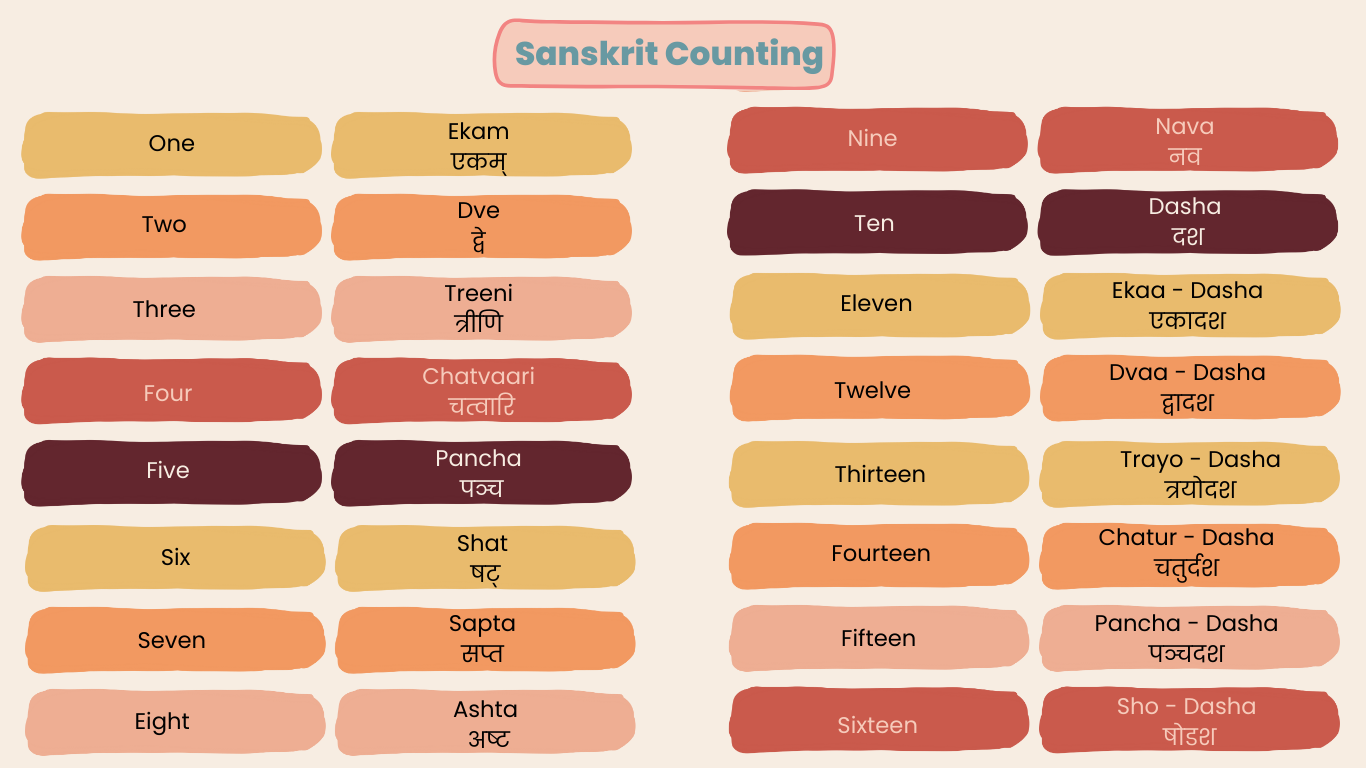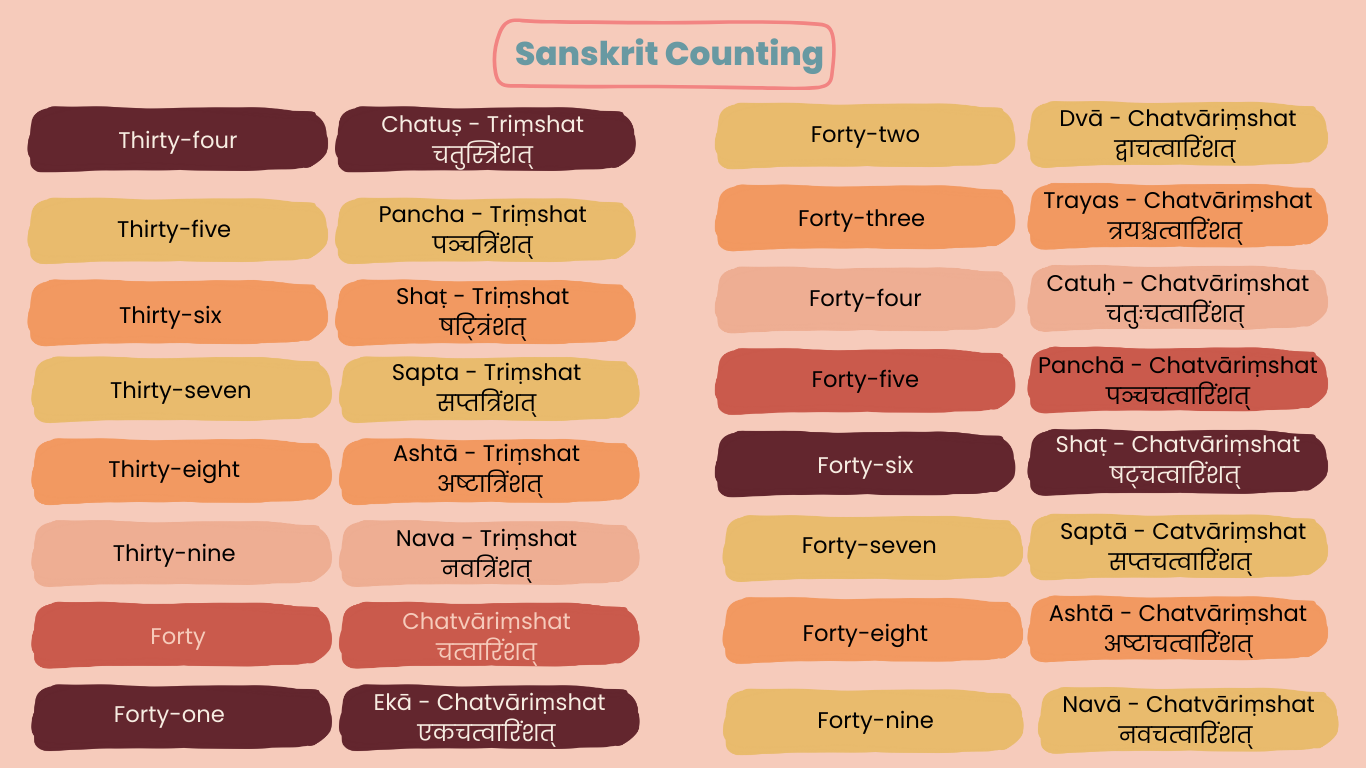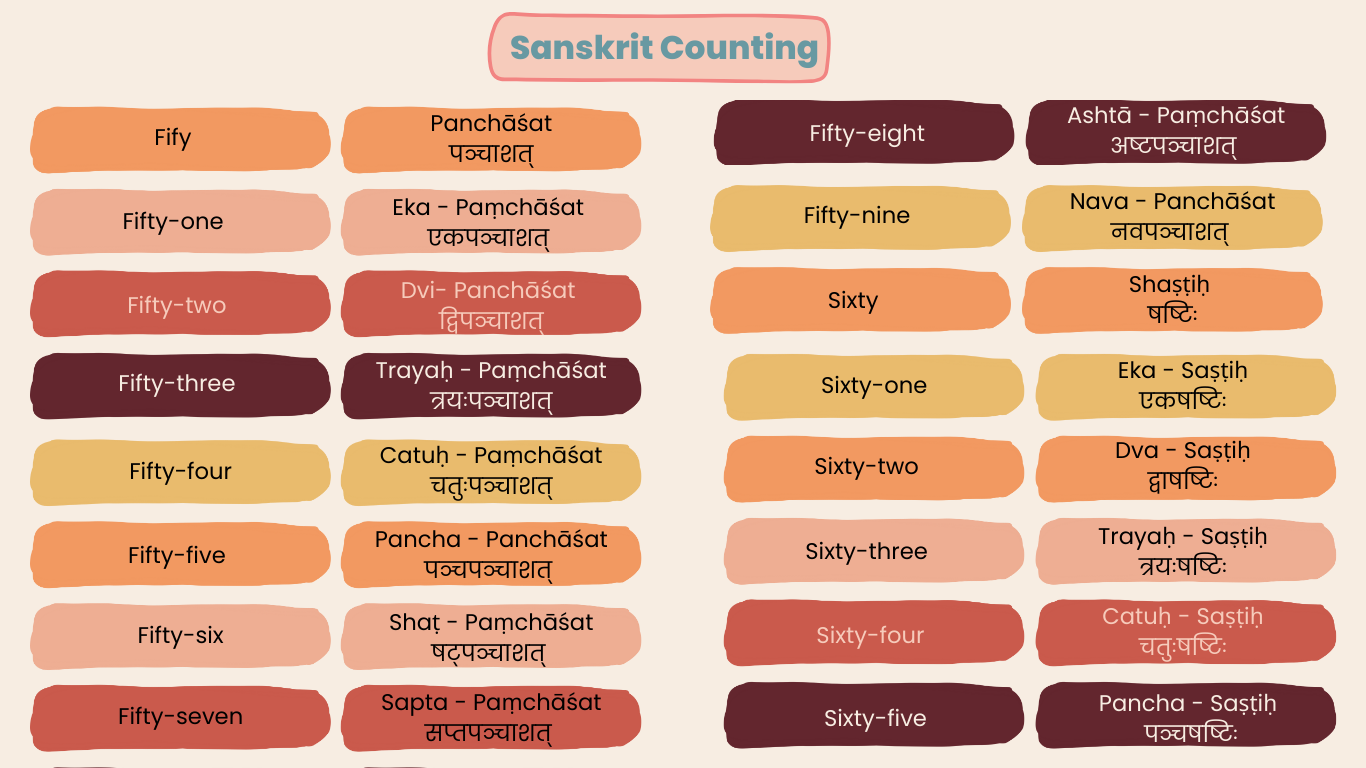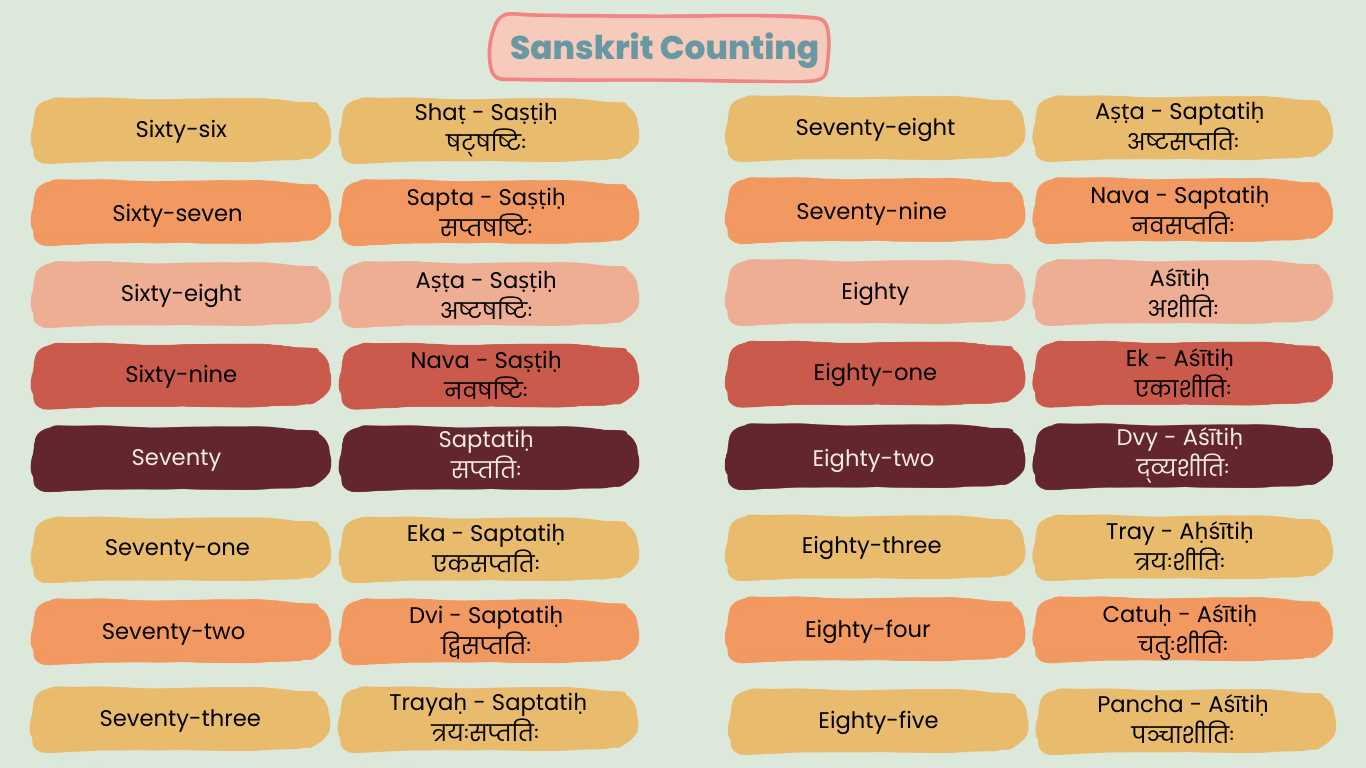Tradition and Authenticity:
Yoga is deeply rooted in Indian cultural and tradition. Learning and using count in Sanskrit honors the origins and maintains the authenticity of the Yoga practice.
This connection and use of Sanskrit count can make the Yoga spiritually enriching for the students.

Connection to the Culture of Yoga:
Sanskrit is the classical language of Yoga, using it in the regular practice can foster a deeper connection to its culture.
It helps students to understand and appreciate the rich heritage, philosophical roots of Yoga and provide a sense of continuity in the ancient practices.
Awareness and Focus:
Counting in Sanskrit requires students and teachers to pay closer attention and stay mentally present.
This helps to maintain the focus on their movement and breathe rather than getting lost in their thoughts.

Uniformity and Consistency:
Yoga is practiced globally. Using Sanskrit as a universal language of Yoga ensures consistency across different parts of world, regions and teachers.
The consistency of the Sanskrit counting in Yoga practices helps to maintain the integrity of the practice and makes it easier for students to practice anywhere in the entire world.
Vibration and Sound:
The Sanskrit language was used by Indian sages and it has unique vibrational qualities. When chanting or counting in Sanskrit different vibrations are created in the body and unique frequencies are released.
The sounds can positively affect the Yoga practitioner’s energy and focus.

Structure and Rhythm:
Counting in Sanskrit provides a structured rhythm to the Yoga practice, guiding the students during the class through each asana with precision and helping them to stay connected with their breaths.
It helps to manage with the time and to control the structure of class.
Professional Continues Education Value:
Learning and using to count in Sanskrit is part of the professional continues education.
It helps teachers to expand their knowledge of Sanskrit terminology which is used in traditional Yoga scriptures, deepening their understanding and appreciation of the ancient Yoga practice.

Global community of Yoga:
Using the Sanskrit creates a sense of unity among Yoga practitioners worldwide.
Its builds a global community that shares a common tradition, culture and language, fostering a sense of unity, belonging and connection.

Learn the Sanskrit counting now:

1 | Ekam एकम् | One |
2 | Dve द्वे | Two |
3 | Treeni त्रीणि | Three |
4 | Chatvaari चत्वारि | Four |
5 | Pancha पञ्च | Five |
6 | Shat षट् | Six |
7 | Sapta सप्त | Seven |
8 | Ashta अष्ट | Eight |
9 | Nava नव | Nine |
10 | Dasha दश | Ten |
11 | Ekaadasha एकादश | Eleven |
12 | Dvaadasha द्वादश | Twelve |
13 | Trayodasha त्रयोदश | Thirteen |
14 | Chaturdasha चतुर्दश | Fourteen |
15 | Panchadasha पञ्चदश | Fifteen |
16 | Shodasha षोडश | Sixteen |
| 17 | Saptadasha सप्तदश | Seventeen |

18 | Ashtaadasha अष्टादश | Eighteen |
19 | Navadasha नवदश | Nineteen |
20 | Vimshatih विंशतिः | Twenty |
21 | Ekavimshatih एकविंशतिः | Twenty-one |
22 | Dvaavimshatih द्वाविंशतिः | Twenty-two |
23 | Trayovimshatih त्रयोविंशतिः | Twenty-three |
24 | Chaturvimshatih चतुर्विंशतिः | Twenty-four |
25 | Panchavimshatih पञ्चविंशतिः | Twenty-five |
26 | Shadvimshatih षड्विंशतिः | Twenty-six |
27 | Saptavimshatih सप्तविंशतिः | Twenty-seven |
28 | Ashtaavimshatih अष्टाविंशतिः | Twenty-eight |
29 | Navavimshatih नवविंशतिः | Twenty-nine |
30 | Trimshat त्रिंशत् | Thirty |
31 | Ekatriṃshat एकत्रिंशत् | Thirty-one |
32 | Dvaatriṃshat द्वात्रिंशत् | Thirty-two |
33 | Trayastriṃshat त्रयस्त्रिंशत् | Thirty-three |

34 | Chatuṣṭriṃshat चतुस्त्रिंशत् | Thirty-four |
35 | Panchatriṃshat पञ्चत्रिंशत् | Thirty-five |
36 | Shaṭtriṃshat षट्त्रिंशत् | Thirty-six |
37 | Saptatriṃshat सप्तत्रिंशत् | Thirty-seven |
38 | Ashtātriṃshat अष्टात्रिंशत् | Thirty-eight |
39 | Navatriṃshat नवत्रिंशत् | Thirty-nine |
40 | Chatvāriṃshat चत्वारिंशत् | Forty |
41 | Ekāchatvāriṃshat एकचत्वारिंशत् | Forty-one |
42 | Dvāchatvāriṃshat द्वाचत्वारिंशत् | Forty-two |
43 | Trayaschatvāriṃshat त्रयश्चत्वारिंशत् | Forty-three |
44 | Catuḥchatvāriṃshat चतुःचत्वारिंशत् | Forty-four |
45 | Panchāchatvāriṃshat पञ्चचत्वारिंशत् | Forty-five |
46 | Shaṭchatvāriṃshat षट्चत्वारिंशत् | Forty-six |
47 | Saptāchatvāriṃshat सप्तचत्वारिंशत् | Forty-seven |
48 | Ashtāchatvāriṃshat अष्टाचत्वारिंशत् | Forty-eight |
49 | Navāchatvāriṃshat नवचत्वारिंशत् | Forty-nine |

50 | Panchāśat पञ्चाशत् | Fifty |
51 | Ekapaṃchāśat एकपञ्चाशत् | Fifty-one |
52 | Dvipanchāśat द्विपञ्चाशत् | Fifty-two |
53 | Trayaḥpaṃchāśat त्रयःपञ्चाशत् | Fifty-three |
54 | Catuḥpaṃchāśat चतुःपञ्चाशत् | Fifty-four |
55 | Panchapanchāśat पञ्चपञ्चाशत् | Fifty-five |
56 | Shaṭpaṃchāśat षट्पञ्चाशत् | Fifty-six |
57 | Saptapaṃchāśat सप्तपञ्चाशत् | Fifty-seven |
58 | Ashtāpaṃchāśat अष्टपञ्चाशत् | Fifty-eight |
59 | Navapanchāśat नवपञ्चाशत् | Fifty-nine |
60 | Shaṣṭiḥ षष्टिः | Sixty |
61 | Ekaṣaṣṭiḥ एकषष्टिः | Sixty-one |
62 | Dvaṣaṣṭiḥ द्वाषष्टिः | Sixty-two |
63 | Trayaḥṣaṣṭiḥ त्रयःषष्टिः | Sixty-three |
64 | Catuḥṣaṣṭiḥ चतुःषष्टिः | Sixty-four |
65 | Panchaṣaṣṭiḥ पञ्चषष्टिः | Sixty-five |

66 | Shaṭṣaṣṭiḥ षट्षष्टिः | Sixty-six |
67 | Saptaṣaṣṭiḥ सप्तषष्टिः | Sixty-seven |
68 | Aṣṭaṣaṣṭiḥ अष्टषष्टिः | Sixty-eight |
69 | Navaṣaṣṭiḥ नवषष्टिः | Sixty-nine |
70 | Saptatiḥ सप्ततिः | Seventy |
71 | Ekasaptatiḥ एकसप्ततिः | Seventy-one |
72 | Dvisaptatiḥ द्विसप्ततिः | Seventy-two |
73 | Trayaḥsaptatiḥ त्रयःसप्ततिः | Seventy-three |
74 | Catuḥsaptatiḥ चतुःसप्ततिः | Seventy-four |
75 | Panchasaptatiḥ पञ्चसप्ततिः | Seventy-five |
76 | Shaṭsaptatiḥ षट्सप्ततिः | Seventy-six |
77 | Saptasaptatiḥ सप्तसप्ततिः | Seventy-seven |
78 | Aṣṭasaptatiḥ अष्टसप्ततिः | Seventy-eight |
79 | Navasaptatiḥ नवसप्ततिः | Seventy-nine |
80 | Aśītiḥ अशीतिः | Eighty |
81 | Ekāśītiḥ एकाशीतिः | Eighty-one |
82 | Dvyāśītiḥ द्व्यशीतिः | Eighty-two |
83 | Trayaḥśītiḥ त्रयःशीतिः | Eighty-three |
84 | Catuḥśītiḥ चतुःशीतिः | Eighty-four |
85 | Panchaāśītiḥ पञ्चाशीतिः | Eighty-five |

86 | Shaṭśītiḥ षट्शीतिः | Eighty-six |
87 | Saptāśītiḥ सप्ताशीतिः | Eighty-seven |
88 | Aṣṭāśītiḥ अष्टाशीतिः | Eighty-eight |
89 | Navāśītiḥ नवाशीतिः | Eighty-nine |
90 | Navatiḥ नवतिः | Ninety |
91 | Ekanavatiḥ एकनवतिः | Ninety-one |
92 | Dvinavatiḥ द्विनवतिः | Ninety-two |
93 | Trayaḥnavatiḥ त्रयःनवतिः | Ninety-three |
94 | Catuḥnavatiḥ चतुर्नवतिः | Ninety-four |
95 | Panchanavatiḥ पञ्चनवतिः | Ninety-five |
96 | Ṣaṇṇavatiḥ षण्णवतिः | Ninety-six |
97 | Saptanavatiḥ सप्तनवतिः | Ninety-seven |
98 | Aṣṭanavatiḥ अष्टनवतिः | Ninety-eight |
99 | Navanavatiḥ नवनवतिः | Ninety-nine |
100 | Shatam शतम् | One hundred |
Conclusion:
Preserve Ancient Sanskrit: Sanskrit often referred to as the “language of the gods” in Indian tradition, is one of the oldest languages known to humanity. By incorporating Sanskrit counting into yoga practices, teachers and practitioners contribute to the preservation and revival of this ancient language.
Honor Yoga’s Heritage: Yoga is a comprehensive discipline with deep historical and philosophical roots. Incorporating Sanskrit counting allows practitioners to appreciate and honor the rich cultural heritage of Yoga, fostering a deeper connection to its origins.
Enhance Growth: Learning Sanskrit counting promotes personal and professional development. For practitioners, it enhances cognitive skills and deepens their practice. For teachers, it adds credibility and distinguishes them as knowledgeable and dedicated professionals.
Authentic Practice: Using Sanskrit counting in Yoga sessions brings an authentic touch to the practice, aligning it with traditional roots. This authenticity enriches the practitioner’s experience and builds trust and respect in the teacher-student relationship.
Lifelong Learning: Yoga is a lifelong journey, and the path of a Yoga sadhaka (dedicated practitioner) involves continuous learning and growth. Integrating Sanskrit counting into practice encourages a mindset of perpetual learning and curiosity.

Popular Courses in Bali
200 hour Yoga Teacher Training in Bali | 300 hour Yoga Teacher Training in Bali | 500 hour Yoga Teacher Training in Bali | 50 Hours Yin Yoga Training in Bali | 50 hours Pranayama Training in Bali | 50 hours Yoga Nidra Training Bali | 50 hours Arm Balancing Training Bali | 100 hour Ashtanga Training Bali
Popular Courses in Germany
200 hour Yoga Teacher Training in Germany | 300 hour Yoga Teacher Training Germany | 50 Hour Yin Yoga Training Germany | 50 Hour Pranayama Training Germany | 50 hour Yoga Nidra Training Germany | 50 Hour Arm Balancing Training | 100 hour Ashtanga Training Germany


